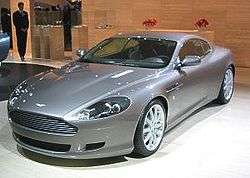Aston Martin VH platform


The VH Platform (for vertical/horizontal platform) is Aston Martin's automobile platform that underpinned their grand tourers and sports cars. It served as the basis for Aston Martin's production cars up until the introduction of the Aston Martin DB11 in 2016, which featured an all-new bonded-aluminium platform that would underpin future Aston Martins.[1] The VH platform was used in all of Aston Martin's lineup at the time excluding the One-77,[2] which uses Carbon Architecture and the Cygnet[3] which is based on the Toyota iQ. There are five variations of the VH platform.
Variants
VH Generation0
The original first-generation Aston Martin Vanquish used an aluminium chassis that evolved into the platform that would go on to underpin all future Aston Martins. At the time it was not considered to be a VH platform but in retrospect it should be treated as one.[4]
VH Generation1
The first official VH Chassis made its debut in the Aston Martin DB9 in 2004, and has underpinned the DB9 through the course of its production run from 2004 to 2016. It was refined in 2008 for the 2009 model year DB9, and again in 2012 for the 2013 model year DB9 where it shared carbon fibre components and hardware technology from the Generation4 architecture that underpinned the second-generation Vanquish which made its debut in 2012.
VH Generation2
The second VH platform underpinned the 2005 Aston Martin V8 Vantage and its V12 and S variants, as well as the bespoke Aston Martin DB10 concept car for the James Bond film Spectre. The DB10 was based on the V8 Vantage chassis albeit with modifications, as it featured a longer wheelbase and is nearly as wide as the Aston Martin One-77. The Generation2 platform was also used in the 2007 Aston Martin DBS, and the 2011 Aston Martin Virage.
VH Generation3
The third VH platform underpinned the Aston Martin Rapide. The platform differs from the first two as it is longer to accommodate the longer four door body.[5]
VH Generation4
Based on VH Generation2, Generation4 underpinned the second-generation Aston Martin Vanquish that was introduced in 2012. It is based on the Carbon Architecture found in the One-77 and uses far more carbon fibre in its design than previous VH Chassis.[6] This is the final iteration of the VH platform, as the Aston Martin DB11 introduced in 2016 features an all-new riveted and adhesive-bonded aluminium platform that shifts the emphasis from extrusions to stampings to create more cockpit space which would also underpin future Aston Martin models.[7]
References
- ↑ Duff, Mike (1 March 2016). "2017 Aston Martin DB11 Revealed!". Car and Driver. Retrieved 11 April 2018.
- ↑ "Carbon Architecture".
- ↑ "Cygnet".
- ↑ "V12 Vanquish".
- ↑ "VH Architecture".
- ↑ "Vanquish".
- ↑ Robinson, Aaron (August 2016). "2017 Aston Martin DB11". Car and Driver. Retrieved 30 January 2018.
External links
Aston Martin Lagonda road car timeline, 1948–present | ||||||||||||||||||||||||||||||||||||||||||||||||||||||||||||||||||||||
|---|---|---|---|---|---|---|---|---|---|---|---|---|---|---|---|---|---|---|---|---|---|---|---|---|---|---|---|---|---|---|---|---|---|---|---|---|---|---|---|---|---|---|---|---|---|---|---|---|---|---|---|---|---|---|---|---|---|---|---|---|---|---|---|---|---|---|---|---|---|---|
| Type | 1940s | 1950s | 1960s | 1970s | 1980s | 1990s | 2000s | 2010s | ||||||||||||||||||||||||||||||||||||||||||||||||||||||||||||||
| 8 | 9 | 0 | 1 | 2 | 3 | 4 | 5 | 6 | 7 | 8 | 9 | 0 | 1 | 2 | 3 | 4 | 5 | 6 | 7 | 8 | 9 | 0 | 1 | 2 | 3 | 4 | 5 | 6 | 7 | 8 | 9 | 0 | 1 | 2 | 3 | 4 | 5 | 6 | 7 | 8 | 9 | 0 | 1 | 2 | 3 | 4 | 5 | 6 | 7 | 8 | 9 | 0 | 1 | 2 | 3 | 4 | 5 | 6 | 7 | 8 | 9 | 0 | 1 | 2 | 3 | 4 | 5 | 6 | 7 | |
| Owner | David Brown | William Wilson | Minden & Sprague | Victor Gauntlett et al. | Ford | Independent consortium | ||||||||||||||||||||||||||||||||||||||||||||||||||||||||||||||||
| City Car | Cygnet | |||||||||||||||||||||||||||||||||||||||||||||||||||||||||||||||||||||
| Luxury Car | Rapide | |||||||||||||||||||||||||||||||||||||||||||||||||||||||||||||||||||||
| 2.6 ltr | 3 ltr | Rapide | Lagonda | Taraf | ||||||||||||||||||||||||||||||||||||||||||||||||||||||||||||||||||
| Grand Tourer | DB4 | DB5 & Volante | DBS & Vantage | DB7 | Vantage | |||||||||||||||||||||||||||||||||||||||||||||||||||||||||||||||||
| DB1 | DB2 | DB2/4 & MKIII | DB6 | DBS V8 & AM V8 | V8 Virage | V8 | DB9 & V12 Virage | DB11 | ||||||||||||||||||||||||||||||||||||||||||||||||||||||||||||||
| V8 Vantage | V8 Vantage | Vanquish | DBS V12 | Vanquish | ||||||||||||||||||||||||||||||||||||||||||||||||||||||||||||||||||
| Limited Production | One-77 | Vulcan | ||||||||||||||||||||||||||||||||||||||||||||||||||||||||||||||||||||
| DB4 Zagato | V8 Zagato | DB7 Zagato | DB AR1 | V12 Zagato | Valkyrie | |||||||||||||||||||||||||||||||||||||||||||||||||||||||||||||||||
| Concept Car | ||||||||||||||||||||||||||||||||||||||||||||||||||||||||||||||||||||||
| Color code |
Aston Martin badge Lagonda badge | |||||||||||||||||||||||||||||||||||||||||||||||||||||||||||||||||||||